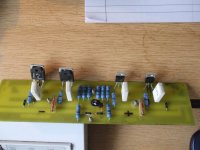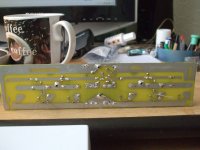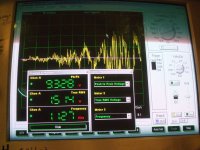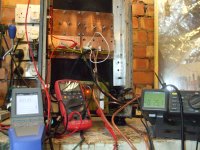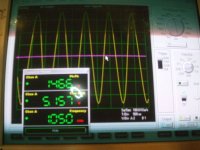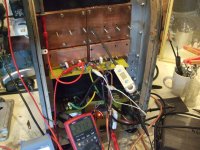FQA19N20 and FQA12P20?
Ashaw you talking to me?
No but if I may ...
Think they are Farchild Mosfest reccomended replacement for IRF parts.
Now not longher in production.
....
My question is FQA19N20 I could not get I got FQP19N20 is the only difference between the 2 just in the paccage?
One is TO247 other is TO220
Ashaw you talking to me?
No but if I may ...
Think they are Farchild Mosfest reccomended replacement for IRF parts.
Now not longher in production.
....
My question is FQA19N20 I could not get I got FQP19N20 is the only difference between the 2 just in the paccage?
One is TO247 other is TO220
what are the FQAN and FQAP transistors. Fairchild parts?
And you are no longer using the 2SK74, 2SJ170... is this due to availability or something else?
quote from F5 production manual
Part Selection
The input JFETs used are 2SK170 or 2SK370 for the N channel parts (Q1), and 2SJ74 or
2SJ108 for the P channel parts (Q2). In these cases the Idss selection code is BL, although
V and GR types will also generally work fine. The primary thing about these particular parts
is the transconductance figure of 20 mS – many of the potential substitutes are much lower
at 4 to 10 mS.
The output MOSFETs are the IRF240 N channel type (Q3) and the IRD9240 P channel type
(Q4). They will want to have a voltage rating in excess of 50 volts, a current rating of about
15 to 20 amps, and a dissipation of about 150 watts. Comparable parts are widely
available, and here I used Fairchild FQA12P20 and FQA19N20C
I don't know. I think you don't want the to-220 anyway, not enough
dissipation.
What you probably want are the Toshiba parts 2SK1529 / 1530 or
2SJ200 / 201
The 1529 and 200 are a little smaller and faster, the others are beefier,
both would be good if you can get them.

dissipation.
What you probably want are the Toshiba parts 2SK1529 / 1530 or
2SJ200 / 201
The 1529 and 200 are a little smaller and faster, the others are beefier,
both would be good if you can get them.
Tanks Nelson
I had a Toshiba F5 running fine.(1530 /201 combo)
I have Just finished matching 100 of the FQA12P20
And started with a batch of FQP19N20
From specs appart from dissipation and Junction to case thermal resistance I could see nothing else apart (of top of my head ) the FQA is rated at 20 A and FQP at about 16 A
The FQA12P20 is only rated at 12A so not shure on how big impact it will make.
Al other parameters sems to be same (between FQA and FQP )
I noticed quite a big difference in VGS (24V 2A 50C) between P and N devices
P Channels at about 5.3XX V N at about 3.7XX volts and not having one to compare (FQA19N20)I am bit stuck.
I supose I beter stop matching for a day or so and get them on a board and and have a listen.
I am quite curious to ear if the (lets call it for semplicity) 4 V VGS of the Faichild make a big difference compared to the 2 V or so of the Toshibas.
I may have to trotle down the Bias a bit (Tosh 1530/201 combo running at 2.7 A on 31 V rails 1.35 A (2on paralell 41.85 W dissipation on each mosfet )
I had a Toshiba F5 running fine.(1530 /201 combo)
I have Just finished matching 100 of the FQA12P20
And started with a batch of FQP19N20
From specs appart from dissipation and Junction to case thermal resistance I could see nothing else apart (of top of my head ) the FQA is rated at 20 A and FQP at about 16 A
The FQA12P20 is only rated at 12A so not shure on how big impact it will make.
Al other parameters sems to be same (between FQA and FQP )
I noticed quite a big difference in VGS (24V 2A 50C) between P and N devices
P Channels at about 5.3XX V N at about 3.7XX volts and not having one to compare (FQA19N20)I am bit stuck.
I supose I beter stop matching for a day or so and get them on a board and and have a listen.
I am quite curious to ear if the (lets call it for semplicity) 4 V VGS of the Faichild make a big difference compared to the 2 V or so of the Toshibas.
I may have to trotle down the Bias a bit (Tosh 1530/201 combo running at 2.7 A on 31 V rails 1.35 A (2on paralell 41.85 W dissipation on each mosfet )
Last edited:
I don't know. I think you don't want the to-220 anyway, not enough
dissipation.

I thought about using multiple to-220
but like with tubes, I came to the conclusion why use multiple smaller ones, when a single bigger one does it
and seems to get unnecessary complicated
still, some of the 220 might be interesting
but not as direct substitutes
then a different design I guess
anyway, for the future
there seems to be put more weight on TO-220 devices
maybe related to classD, car stereo, etc
Hasn't this been around?

Hi NP,
You did mention applying a "several hundred" ohm pot across the jFet source resistors previously, but never showed this schematic with a "P3." Is it an older one? Several values are slightly different as well as the thermal compensation being in a different spot.
...a pair of the TO-220 Fairchilds don't look half bad...
If we look at capacitance to Yfs ratio it can get even more attractive....
Sorry for off topic question, but can't something similar be done with F4?
You can use Toshibas. Is that what you had in mind?
You can use Toshibas. Is that what you had in mind?

Yes, but no. I was interested in the concept of being able to manipulate the distortion, deciding whether or not I like second or third. If nothing else, it would be a good learning experience. I have parts coming for both and from what i have read, the F4 is second, while the F5 is third. Perhaps this doesn't matter, but i don't know as i have never been in a position to hear both interchangeably. I do have the fets for Juma's version, as it was given quite the review. Great thing is, I will have stuff for both Juma's and yours... as well as F4.
Tanks Jaco Juma and Jim
Yes capacitance was one atractive thing of the TO220
Also current rating is closer being the FQAP20 rated at 12.6A
FQA19N20 rated at 23A and FQP19N20 at 19.4 A (max curent at 25 C from data sheet).
I had Pm from Jim that mention about he having same VGS diference on N and P Channels on the Fairchild TO247 so I just have to give it a go and have a listen.
I have 100 each of the FQA12P and FQP19N if any one would be interested in swaps and such Just let me know.
I would like to swap same of the FQA12P20 with same FQA19N20 (course I would)
While there I am going to rig up P3 (using 1 K pots while I wait for delivery of same 200)
And report Back
Tanks you al realy apreciated
Yes capacitance was one atractive thing of the TO220
Also current rating is closer being the FQAP20 rated at 12.6A
FQA19N20 rated at 23A and FQP19N20 at 19.4 A (max curent at 25 C from data sheet).
I had Pm from Jim that mention about he having same VGS diference on N and P Channels on the Fairchild TO247 so I just have to give it a go and have a listen.
I have 100 each of the FQA12P and FQP19N if any one would be interested in swaps and such Just let me know.
I would like to swap same of the FQA12P20 with same FQA19N20 (course I would)
While there I am going to rig up P3 (using 1 K pots while I wait for delivery of same 200)
And report Back
Tanks you al realy apreciated
Just before I disaper in the loft for the next few hours I tought maybe I can post a couple of pictures of the Fair PCB.
I got room for a triplet but I do not realy make to many changes as I want to compare the sound of the Fairchild with the Toshibas
So I am commited now: 31V 2.5 A rails about 42 W disipation on each.
If they blow I think it be handy to know (I got speaker protection that need a proper testing as well)
If you do not hear from me soon it means that I am to busy listening to sweet music
Cirio
I got room for a triplet but I do not realy make to many changes as I want to compare the sound of the Fairchild with the Toshibas
So I am commited now: 31V 2.5 A rails about 42 W disipation on each.
If they blow I think it be handy to know (I got speaker protection that need a proper testing as well)
If you do not hear from me soon it means that I am to busy listening to sweet music
Cirio
Attachments
Thanks for nothing
On second thought, mea culpa, seems my pdf viewer has hickups when i've opened up a zillion datasheets simultaneously.
The FQP parts are the same die in a smaller jacket, Ciss/Crss numbers are identical to those of the FQA biggies.
Pd is down a fifth to a quarter for the TO-220's, with the way inferior thermal resistance number for the insulation added, max dissipation drops by 35 to 40 percent.
(not even bad actually, still pretty amazing to see TO-220 parts do way beyond 100W, me remain frozen solid at the 75W limit of the 1980s)
The highly elevated thermal insulation figure had me mount TO-220 output stages bareback on heatsinks, saves half a C per W.
Rjc is divided by the output device number, with a wee bit more heatsink (or a fan), a naked TO-220 output stage can match the heat level of a TO3(p) one.
Tanks Jacco
I got the thing running (ang on a minute may be ugly but still F5 )
So re start
I got the first channel of the F5 running with the Fairchild and tought about posting same results.
First impression sound wise on Gales Gold monitors (4 Homs ).
Bit more dinamics and gain bit less harshnes on Hi frequency when compared to the Toshibas.
1)Just warming up at the sound of Doors and taking it easy at first
2)the rig (yess sorry 3 meters one just mesuring current on the positive rail bit like belt and braces
3)1 KHz 14 volts peack (for now )
)
4)2.7 A (rail )38 C on the heat spreader about 1 and 1/2 hour in A bit less than what I was especting to be onest it maight mean that the heat is staiing in the mosfet.
Just for those that missed a bit (no much chance of that me think)
I use Kerafol 86/83 on 13 mm thick coper heath spreaders Mosfets are bolted realy tight and sprereaders are bolted on to the heat sink (300 X 400 X83)on hand lapped faces with a bit of graphite thermal grease the lot is capable to dissipate 250W for a sink themperature of 50 C
I will need to mesure up the Junction temperature at the Drain pin as close to body of one of the FQP19N20
So same 200 Homs pots and a tiny PT100 on order.
Tanks for help
PS R5 and R6 are still 2.2K same as for Toshibas I remember there was an isue with tose values a while ago so it may be handy to know
PSS watch out for + felt tip on board of my previous post is wrong and you may cause same serious dammagge
I got the thing running (ang on a minute may be ugly but still F5 )
So re start
I got the first channel of the F5 running with the Fairchild and tought about posting same results.
First impression sound wise on Gales Gold monitors (4 Homs ).
Bit more dinamics and gain bit less harshnes on Hi frequency when compared to the Toshibas.
1)Just warming up at the sound of Doors and taking it easy at first
2)the rig (yess sorry 3 meters one just mesuring current on the positive rail bit like belt and braces
3)1 KHz 14 volts peack (for now
4)2.7 A (rail )38 C on the heat spreader about 1 and 1/2 hour in A bit less than what I was especting to be onest it maight mean that the heat is staiing in the mosfet.
Just for those that missed a bit (no much chance of that me think)
I use Kerafol 86/83 on 13 mm thick coper heath spreaders Mosfets are bolted realy tight and sprereaders are bolted on to the heat sink (300 X 400 X83)on hand lapped faces with a bit of graphite thermal grease the lot is capable to dissipate 250W for a sink themperature of 50 C
I will need to mesure up the Junction temperature at the Drain pin as close to body of one of the FQP19N20
So same 200 Homs pots and a tiny PT100 on order.
Tanks for help
PS R5 and R6 are still 2.2K same as for Toshibas I remember there was an isue with tose values a while ago so it may be handy to know
PSS watch out for + felt tip on board of my previous post is wrong and you may cause same serious dammagge
Attachments
Last edited:
Hasn't this been around?

If you're still biasing it into Class-A, R7 and R8 should probably be heftier than 3W, n'est ce pas? Perhaps 1 ohm/3W in parallel with 2.2 ohm/3W.
Last edited:
I ran a DC simulation with Bob Cordell's MOSFET models to illustrate the effect of the higher source resistance:
Transconductance is more linear at higher Id:
An externally hosted image should be here but it was not working when we last tested it.
Transconductance is more linear at higher Id:
An externally hosted image should be here but it was not working when we last tested it.
- Home
- Amplifiers
- Pass Labs
- F5 power amplifier
